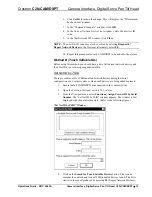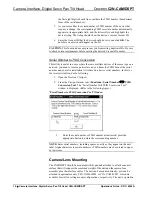
Camera Interface, Digital Servo Pan Tilt Head
Crestron
C2N-CAMIDSPT
2
•
Camera Interface, Digital Servo Pan Tilt Head: C2N-CAMIDSPT
Operations Guide - DOC. 6262A
Panning and Tilting
Pan/tilt axis control can be performed with a joystick or other speed and direction
control by sending values to the symbol PanRate and TiltRate analog input joins or
by commanding the unit to go to a specified position by sending commands to the
PanPos and TiltPos analog input joins.
For position commands, either the speed to position or the time to reach the position
can be specified via the PT-Spd/Time-Adj digital and the PT-Spd/Time analog input
joins.
Lens Control
Lenses can be either a motorized type or a servomotor type. Motorized lenses
respond to an output voltage that controls both speed and direction of movement.
Servo motor type lenses respond to input voltages in the range of 2.5 to 7.5V. The
CAMIDSPT supports output drives for zoom, focus, and iris lens functions for both
types of lenses. In addition, iris control either by the CAMIDSPT (local) or by a
camera (auto) can be selected via digital input joins.
Motorized Lenses
Motorized lenses respond to positive or negative output voltages to determine the
speed and direction of movement. For example, for a 12V motorized lens, maximum
forward speed occurs when the output voltage is at +12V, and maximum reverse
speed occurs when the output voltage is -12V. Lens motion stops when the output
voltage is zero volts. Output drives for zoom, focus, and iris are provided.
NOTE:
Most CCTV lenses are two motor lenses and do not support remote iris
control. For these lenses, the IRIS_LOCAL/AUTO_MODE digital input join should
be set to AUTO.
The CAMIDSPT supports motorized lenses with potentiometer feedback for the
zoom and focus lens functions. With potentiometer feedback, the position of the
zoom and focus can be determined, which allows storing and recalling of presets. In
addition, with potentiometer feedback, the lens can be commanded to a specific
position by sending values to the ZOOM POS and FOCUS POS analog input joins.
These would normally be used to implement controller-based presets.
Servomotor Lenses
Servomotor lenses respond to voltages in the range from 2.5V to 7.5V at the zoom,
focus, and iris control pins. In addition, servomotor lenses operate in one of two
modes: speed mode or position mode. The mode determines how the lens responds
to the output voltages. The CAMIDSPT allows the mode of the zoom, focus, and iris
to be set independently via the three Spd/Pos mode digital input joins.
Servomotor Lens Set to Speed Mode
When a lens is put into speed mode using the symbol speed/position mode digital
input join, the lens interprets voltages at the output pins much like a motorized lens:
7.5V is the maximum forward speed, 2.5V is the maximum reverse speed, and 5.0V
is stop. Lens rotation will continue as long as a voltage other than 5V is applied. In
speed mode, no positional information is available so neither the internal presets nor
controller-based presets can be used. Speed mode can be used for basic lens
positioning when no positional feedback information is required. Speed mode
outputs for zoom, focus, and iris are supported. Iris control can be set to local or auto
via digital input join. In speed mode, the CAMIDSPT responds to signals at the
ZOOM RATE, FOCUS RATE, and IRIS RATE analog input joins. In this mode the
Содержание C2N-CAMIDSPT
Страница 1: ...Crestron C2N CAMIDSPT Camera Interface Digital Servo Pan Tilt Head Operations Guide...
Страница 4: ......





















